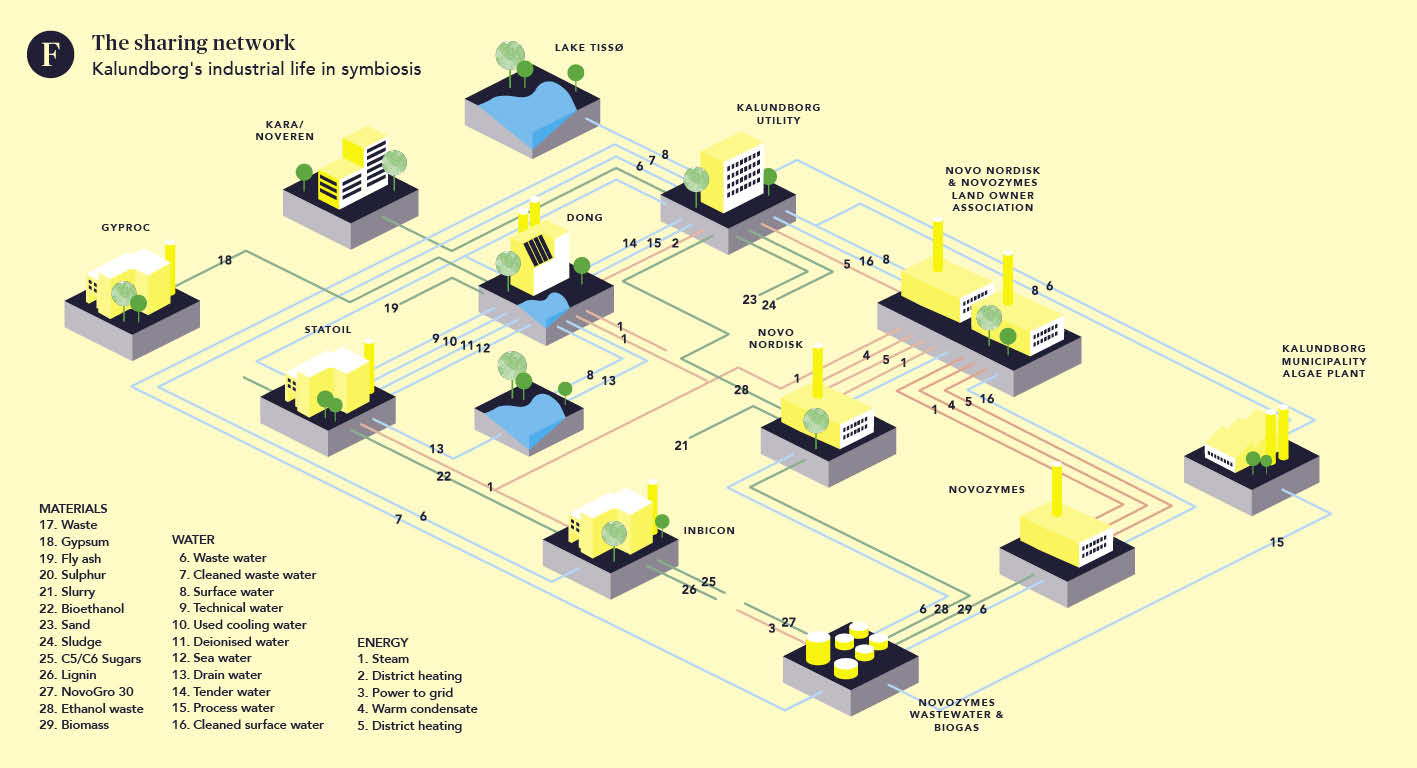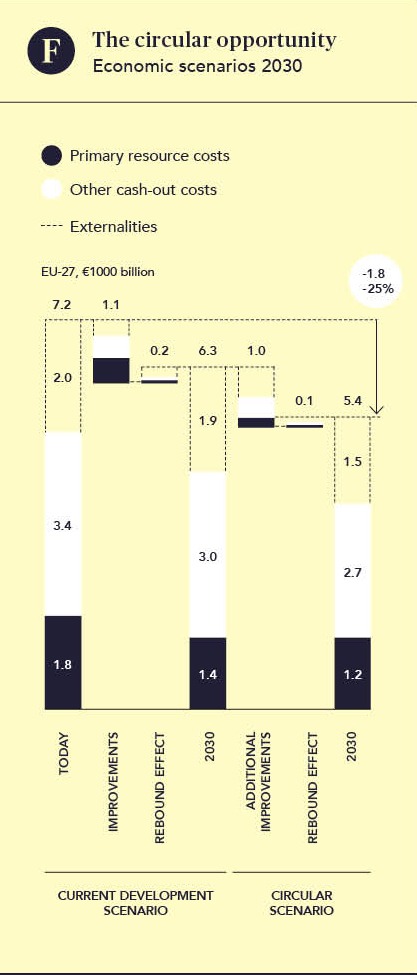One man’s trash is another man’s treasure and never more so than in industrial processing. Reuse of waste products in a closed-loop industrial eco-system brings many benefits to participating companies. But it takes a large measure of shared trust to achieve such close symbiosis, as the town of Kalundborg demonstrates.
THE CIRCULAR ECONOMY When Jørgen Christensen regularly met with fellow Rotarians back in the 1970s he was not to know that their casual conversations about managing the resources of their respective companies would lay the groundwork for a town project that today draws attention from around the world.
Back then Christensen was plant manager at Novo Nordisk, the world’s biggest producer of insulin. Other members of the Rotary Club, in the town of Kalundborg an hour’s drive west of Copenhagen, had similar management positions. Some were CEOs at the biggest industrial companies in town. It was natural to not only discuss their work triumphs, but also their work concerns. One had too much surplus steam, another needed better alternatives for cleaning its waste water. The companies were all located within a 1.5 kilometre radius and before long ideas emerged on how they could work together on resource sharing and by-product exchange.
The local oil refinery, now owned by Norwegian Statoil, originally agreed to provide excess butane gas to neighbouring Gyproc, a gypsum wallboard manufacturer. Later, steam from the city’s power station was led to Novo Nordisk, which used it to clean tanks, while yeast slurry from the production of insulin could be used as fertiliser by local farmers. And so it began. Without recognising it until many years later, the Rotary Club members were laying the foundation blocks for an industrial future consisting of more than 50 bilateral, commercial agreements between a number of major industries, with the municipality’s utility services integrated into what has become known as the Kalundborg Symbiosis. “It started long before it got a name. Basically, we just set up a number of rational collaborations that all players could benefit from,” says Christensen. The Rotarians knew each other well and their thoughts ran along similar lines, he recalls. “In a lot of places, you see that companies are terribly afraid of talking to each other about business ideas. But we weren’t. There was a mutual trust between us, which made it easy to establish partnerships.”
The network that links the companies today is perhaps the longest standing industrial collaboration of its kind anywhere.
[caption id=“attachment_6383” align=“aligncenter” width=“683”]  Transparently obvious. Light dawned for business leaders in Kalundborg when it became clear that waste products from one industrial process could be put to good use by another company just up the road. Industrial symbiosis in a waste sharing network was born.[/caption]
Transparently obvious. Light dawned for business leaders in Kalundborg when it became clear that waste products from one industrial process could be put to good use by another company just up the road. Industrial symbiosis in a waste sharing network was born.[/caption]
Full circle
Turning waste into wealth not only preoccupies industry, but also entire countries. The quest to improve resource productivity, reduce exposure to price volatility and dispense with wasteful practices has given rise to the whole concept of the circular economy and the part to be played by industrial symbiosis. Both the European Union and China have adopted the circular economy as a policy objective. By designing goods and products as integral parts of large industrial ecosystems, they can be turned into resources for reuse at the end of their useful lives, mimicking the circular flow of biological materials in nature. In the circular economy, resources are reused, recycled and recreated in new life cycles instead of following today’s common linear value chain of make, use, and dispose. In theory the new approach could add billions of dollars to the economy.

Just under the radar
Trade and exchange is as ancient as the sharing of hunt kills by early societies, says Marian Chertow, who heads the industrial environmental management programme at Yale University. A variety of “symbiosis projects” like that in Kalundborg are quietly evolving under the radar, she says. In Kalundborg, water, heat and energy flow along pipeline networks directly connecting the cooperating companies in a closed loop industrial system that saves money for all involved. “You can’t really see industrial symbiosis. It happens because of private interests among companies. One company needs energy, another company has extra steam. So they make a one-to-one deal. That’s not a newspaper headline,” says Chertow. She adds there are many such cooperative initiatives that could be considered industrial symbiosis. They often start as joint ventures and gradually develop into industrial ecosystems.
“So when is industrial symbiosis going to scale? My least favourite phrase. The point is that it doesn’t just go to one big scale — it pops up everywhere. We just haven’t had the eyes to see it until now,” she says. The dynamics of industrial symbiosis can differ significantly, a point made in a newly published study by Chertow and colleagues. In China, 106 huge industrial estates have been organised to cooperate on resource management with the backing of government financing and authority involvement to guide companies on what to do. Industrial symbiosis often starts among companies in already related sectors, whether or not they are linked by material flows. Those that are most successful are driven by a mix of benefits, including financial return, access to new sources of revenue and cost reduction, says Chertow. “It’s not easy, however, because often a lot of infrastructure has to interact. It’s a big and societal issue.”

Inciting change
Evidence suggests that industrial symbioses can improve the competitive ability of the participants and bring societal benefits, by frequently internalising pollution costs and building resilience in the local economy. Novo Nordisk has never calculated the total financial benefits of its participation in industrial symbiosis, but the benefits of diverting streams of unwanted by-products and waste energy to nearby enterprises are clear, says the company’s Michael Hallgren. “The normal and expensive way of getting rid of e.g. the nutritious yeast slurry from our fermentation process is to send it to a treatment plant. Instead, we pass it to biogas plants that use the yeast slurry to produce energy,” he explains. Novo Nordisk is just one of the companies reaping the rewards of a long and dedicated engagement in Kalundborg’s industrial symbiosis. To establish new industrial symbioses that save money and energy, companies may have to change perspective when facing challenges. “You have to be able to see beyond your own nose in order to achieve a common return on investment. Otherwise, a symbiosis won’t be successful,” Hallgren stresses. Persuading companies to do things differently is what makes it hard to access the trilliondollar opportunity the circular economy represents, points out Paul Ekins, who heads the sustainable resources institute at University College London. “The whole purpose of industrial symbiosis is to facilitate that different way of looking at materials, to bring companies in touch with each other who may not normally be in touch and enable them to realise that they have resources, which they are regarding as waste but are of value to other companies,” says Ekins.
The really big wins are in manufacturing sectors because they use most materials. Whether looking at energy, water, chemicals, pulping paper or steel, across the whole range of materials there are opportunities to use resources more effectively and efficiently, Ekins adds. “We can certainly speed up the material sharing networks, either by putting them in geographical proximity with each other, or by having facilitated networks and databases, which is the way it is growing in many countries right now,” says Ekins, who is former chairman of the UK government-funded National Industrial Symbiosis Programme. With 15,000 participants from all industry sectors it is regarded as the country’s most successful e ort to improve resource productivity.
Spreading the word
On the other side of the world in Western Australia, Kwinana is home to one of the largest concentrations of heavy industry anywhere with material flows between companies to increase operational effciency and reduce waste and harmful emissions. Utility operations, including power supply and wastewater treatment are part of the process. Led by Curtin University and Kwinana Industries Council, the reuse of waste and sharing of infrastructure has improved material efficiency and the environmental performance of the area’s energy, minerals and agriculture industries. According to Michele Rosano at Curtin University, one of the big challenges in creating more industrial clusters is to replicate the work done by independent facilitation units like Kwinana Industries Council, or the Symbiosis Center Denmark at Kalundborg, particularly their promotion of the benefits of symbiotic exchanges to the rest of the country.
“Companies need to see that they have resources they regard as waste that are of value to other companies nearby”
Moreover, both centres are instrumental in easing the way for material to flow between companies, particularly when issues of commercial confidence arise. A significant obstacle for symbioses is trust and confidentiality. “Competing industries may not want to talk or participate because they simply don’t want to share any confidential information about their operations,” Rosano says. Another obstacle is finance. Obtaining capital to finance cross-company infrastructure projects is difficult and many industrial projects end after the initial funding runs out. “I’ve seen presentations over the years by banks talking about the value of industrial symbiosis but I haven’t seen anyone formalise any proactive initiatives to support it yet,” says Rosano. •
 One of a kind
One of a kind
. ˮKalundborg Symbiosis is an archetype by which others are judged. It’s really taken us some time to figure out the mechanisms of Kalundborg and fit that into the broader puzzle of what industrial symbiosis is all about,ˮ says Yale’s Marian Chertow.
..
TEXT Sofie Buch Hoyer / PHOTO Mikkel Russel